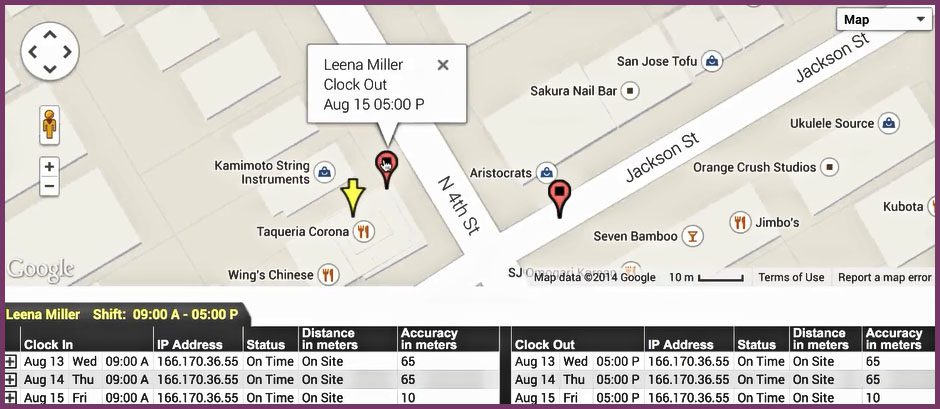Many employers want to track employee location. Depending on where employees are during work, there are two ways to accomplish employee location tracking.
- For office employees
- For mobile employees
Location tracking for office employees
You can track the location of office employees to ensure they’re only clocking in from the office and not from some location before they even get to work. With an online service like Timesheets.com, you can setup authorized IP addresses so that employees never clock in or out from anywhere else. Restricting clock in/out to specific IP addresses ensures that employees are on site and not at Starbucks or on the road somewhere.
Location tracking for mobile employees
GPS tracking for employees is great for field workers. Construction workers might use this feature when they clock in and out at a job site. In-home nurses might use this when they clock in and out from a client’s home. There are all sorts of employees that don’t work in offices that would benefit from this feature.
Top Benefits of Employee Location Tracking
Accountability
Data to back up an employee’s claim that he/she was on the clock and on location is priceless. Both employee and employer like having data to prove their case.
Monitored employees make better decisions
When employees know that their location is being tracked, they are more likely to follow the rules. Even with the occasional presence of a low-accuracy entry, employees know that their location is known, overall, and that they can’t get away with clocking in and out from unapproved locations.
Data that support client billing
The more validating data you have to offer clients, the better your chances of getting paid quickly. Accounting departments often postpone payments while tracking down more information to support a bill. Geolocation data lends more proof to the accuracy of billing.
Workforce allocation visibility
If you are deploying your workforce in various areas, you can see your workforce allocation clearly on the map and make appropriate adjustments. You can view a map of past entries in the Location Report on the Reports page to see coverage over an area.
How GPS Time Tracking Works
Geolocation tracking, or GPS tracking, is most useful for employees who work out in the field. You might want to know which job they’re on or just that they’re on location and not across town when they clock in.
It’s important to note that geolocation tracking uses any one of several tools for tracking a user’s location. This may or may not include GPS. (GPS time tracking is not, technically, GPS tracking, although that’s how most people refer to it. Real GPS tracking would involve the installation of a GPS tracking device, say on someone’s vehicle.) With geolocation, a smartphone, laptop, desktop, or tablet uses the software and hardware installed on it combined with its settings to gain location data. At any given time and for various reasons, it may choose to use GPS, cell tower triangulation, WI-FI positioning, or even the device’s IP address to determine coordinates. Geolocation will work better on some devices and at certain times and places than others.
Our location data is always going to be the best possible data that any device can produce and most of the time it will be good, usable data. But there are going to be some junk entries from time to time. That is just a limitation of the technology at present.
How to Get the Best Geolocation Data
Geolocation technology is a part of all new devices and internet browsers. When enabled, our time tracking software can utilize that technology. The technology is new, however, and does require updated browsers that support it. The following is a list of browsers that support geolocation functionality:
- Microsoft Internet Explorer 9.0 and up
- Mozilla Firefox 3.5 and up
- Apple Safari 5.0 and up
- Google Chrome 5.0 and up
- Opera 10.6 and up
- iPhone 3.0 and up
- Android 2.0 and up
Additionally, GPS can be enabled/disabled on a device, so to give the geolocation technology the best possible opportunity of acquiring accurate data, GPS should be turned on. Lastly, Geolocation works best when the device is within reach of the various signals that it uses to determine coordinate. This may be GPS, cell towers, or WI-FI networks. To ensure that the device reaches these signals, it is best to clock in and out by a window or outside and not in a tunnel or basement.







4 Responses
Hi,
Your solution looks great! I’d like to know if we can limit the app to only allow employees to log in and out from our two office locations. Thanks!
Hi Daniela!
You can setup IP address restrictions so that they can only add time from those locations. Their phones would need to be connected to company wifi in order for it to work for them.